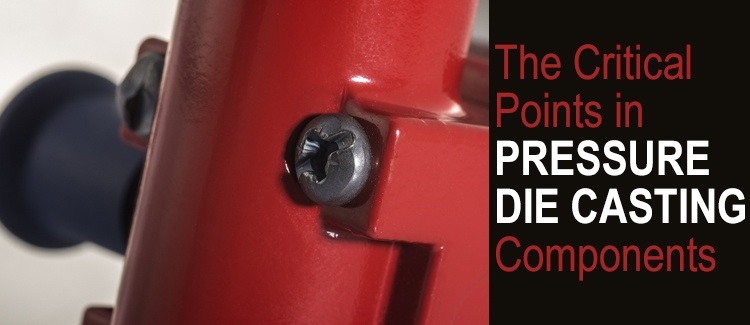As winner of numerous international awards, Bruschi Spa is known for its innovative approach in design and technology. We are glad to share our insights and experiences with the industry members.
The critical points in pressure die casting components
There are rules that need to be considered to design products or components in pressure die casting. The application of these advices will lead to a design that is logical, efficient and cost saving. In this article we will list some critical points to be taken into account when designing pressure die casting components.
To optimize the process and to successfully avoid the critical points in pressure die casting components, it is important to know the material reactions in every phase.
Parting line geometry
When arranging the parting line, that is given by the design of the component, the designer should consider the available position and length for the liquid metal to flow into the cavity. It is also important to remember that adequate gate area will be needed and if the gate length is restricted it will need to be thick with possible consequence of trimming problems. To overcome those problems, the solution could be changing the geometry of the component.
Section thickness
When designing a component, it is crucual to remember that thin walls could be proportionally stronger than thicker ones. That feature allows to use less material and can be produced more quickly in a cost saving way.
Section ratios
It is better to develop components with a fairly constant section thickness. Anyway, in real production, it is possible to make exceptions of this rule if the zinc die caster supplier has expertise and know how to do that.
Checking thickness ratios using the inscribed sphere technique
To avoid porosity the designer could reduce the ratio of inscribed sphere diameters.
Draft angles
Draft angles could be useful to prevent the casting sticking on the moving die. This precaution increases costs, but it is necessary to avoid secondary machining operations.
Design to assist die filling
During the consideration of the parting line of the component it is important to focus on the position and length available for the ingate. In fact good surface finishes and low porosity could be difficult to reach if the available position doesn’t give the chance for the metal to flow into every part of the casting.
Ribs
Strengthening a casting without thickening is possible with ribs, that should be rounded and blended and arranged to join adjacent sections.
Flat surfaces
Flat smooth surfaces are the most expansive design feature of zinc die casting production. There are many ways to manufacture a more attractive product, and at the same time to reduce the cost of production. Improving the collaboration between your designers and the right zinc die casting supplier, in a co-design activity, could help to reach goals without waste resources.
Crowning
Slight crowning and rounding of the corners will reduce distortion in case of plain flat highly finished surface.
Textured Surfaces
To increase the surface quality is possible to choose surface effects.
Fillets and Blends
Sharp corners can be avoided using fillets to have a strengthening effect. It’s a common die casting practice to use a fillet with a minimum radius of 1.6 mm on inside edges. A slight radius on outside corners is an effective cost-saving measure.
Lettering
If lettering is required, it is better for designers to use raised lettering, instead of depressed lettering. Raised lettering allows to limit costs and minimize risks in terms of mold erosion.
Inserts
Placing cast in the die inserts slows down the process and increases costs, for this reason nowadays inserts are less used than in the past.
Dimensional Tolerances
One of the main advantages of the zinc die casting process is the ability to produce complex components with excellent precision in terms of smaller tolerances.
Best achievable linear tolerances
It’s really important to work closely with the die caster, in ongoing co-design activity, because during die casting process linear tolerance band within 0.1% of dimension are allowed at the 8 standard deviations confidence level. This dimension can be reached only when the geometry of the component is favorable to consistent shrinkage without distortion following the ejection from the die.
Design to avoid local die overheating
Designers should develop products or components paying attention to issues caused by die overheating, that can give surface porosity, drag marks and cracks.
How to avoid hot spots by good component design
Preventing heat developed in vulnerable areas is necessary a good design. The right zinc die casting supplier could help to reach goals with its technology and expertise.
Designing to avoid moving cores
Complex three-dimensional shapes are achieved by using moving cores, which slide in the die. If designers can achieve a sufficient effect without moving those cores, this will be a cost saving action.
Avoiding weak die features
It is not suggested to develop product or component using mold with weak features. It could be expensive in economic and time terms.
Cast screw threads
Secondary operations for threads are necessary in case of requirement an unscrewing core. In other cases the designer could choose if it is better to use casting or secondary machining.
Design for reliable die ejection
An ejector pin need to be put near where the casting will tend to grip the tool. It must ensure that the casting and the runner are moved squarely without distorting the component.
Bosses
Bosses heavier than thin walls give unequal shrinkage, creating “shrink marks” that are shallow depression on the face of the casting opposite to the thickened section.
Cored holes
Cored holes can eliminate drilling and machining during the casting.
Machining allowance
If the machining is unavoidable, it is recommendable an allowance of 0.25 mm.
To be updated on trends and innovations in the Zinc Die Casting industry, you are welcome to subscribe to our blog.


